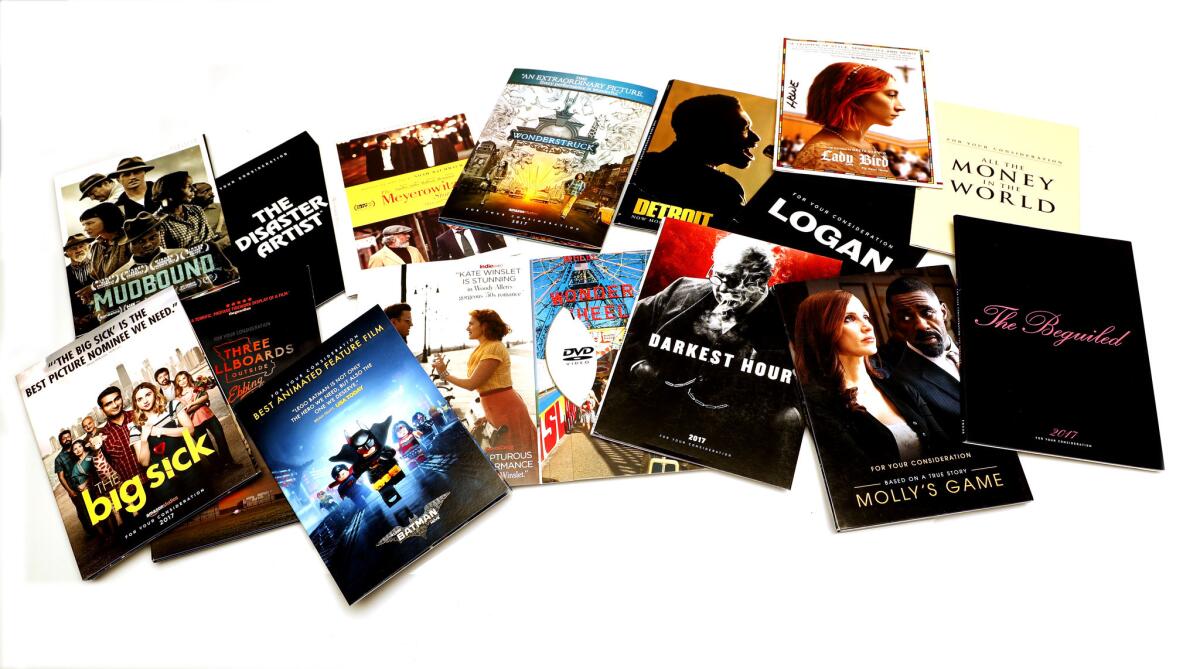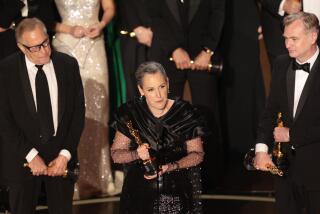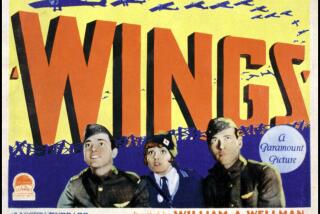The Oscar screener was invented by accident, and other secrets of an awards season staple

Filmmaker John Boorman was desperate.
Despite great reviews, his 1985 movie “The Emerald Forest” wasn’t getting a for-your-consideration Academy Awards campaign from its distributor, which was in disarray. Few members of the Academy of Motion Picture Arts and Sciences had seen the drama, and Boorman feared it would be overlooked.
So he arranged in January 1986 for several hundred VHS copies of “The Emerald Forest” to be made available for free to academy members at local video rental stores. He took out ads in entertainment trade publications to alert Hollywood to his effort, splitting the $15,000 cost with the distributor.
“It was just a rather desperate act of trying to get some recognition for the picture,” said Boorman, 85, who directed and produced the Powers Boothe-starring film. “I was aware that it hadn’t been done before.”
“It was just a rather desperate act of trying to get some recognition for the picture.”
— Filmmaker John Boorman.

“The Emerald Forest” didn’t get any Oscar nominations — but Boorman’s gambit made an impact: He effectively invented the movie screener, now an integral part of Hollywood’s awards season apparatus. Screeners ensure that influential entertainment business players who vote for the Oscars and other awards shows can easily watch contending films. Studios and guilds still show movies in theaters for voters, but many people rely on the DVD screeners to watch the crush of films in contention. With 100,000-plus people eligible to receive the discs, an estimated 1 million or more are sent out annually.
For just a few months a year, screeners have a special showbiz currency, a kind of prestige. The flimsily-packaged DVDs have become cultural signifiers — connoting access, insider status and power for those who receive them, rightfully or not.
“It’s the happiest time of the year,” said producer Bill Gerber, an academy member whose film credits include “Gran Torino” and “Grudge Match.” “There is something about getting screeners in the mail — it is just special.”
“It’s the happiest time of the year. There is something about getting screeners in the mail — it is just special.”
— Producer Bill Gerber
Screeners have been known to help the awards chances of smaller films with minimal distribution and slim marketing budgets. But industry veterans have not always been comfortable with their use. The complaints have focused on artistic integrity, with some people believing awards voters should see films — especially epics and other big pictures — in a theater.
Those doubters could soon have more to fret over due to the ubiquity of streaming. In recent years, the academy has introduced streaming options during the preliminary voting phases in some awards categories, including feature animation. The effort is expected to grow, and some among the academy’s roughly 7,250 voting members aren’t thrilled.
“The downside is you have the option to view the flick on a small device, doing a disservice to the film, and its makers,” said Tony Angellotti, a Hollywood awards consultant and academy member. “Does the process of judging awards of merit get tainted if you aren’t seeing [films] — forget on the big screen — but not even on your 65-inch TV?”
But streaming platforms offer enhanced security that an eminently shareable DVD cannot match. Copyright infringement has long been a negative side effect of screeners, with several instances of purloined copies of films winding up on the internet over the years. In December, hackers illegally distributed four movies, including Oscar hopefuls “Call Me by Your Name” and “Lady Bird.”
The discs, which studios pay to have made and disseminated, typically include language that warns of fines and prison time for criminal copyright infringement. Many also include prompts that say the DVDs must not be shared and should be “securely destroyed” by Oscar Sunday. Some screeners also contain watermarks, which allow them to be traced to their intended recipient.
Though widespread sharing of screeners among friends, family and colleagues continues unabated, the watermarking system seems to work. The only person besides disgraced mogul Harvey Weinstein to be booted from the film academy is Carmine Caridi, the “Godfather: Part II” actor who was dismissed in 2004 for giving his screeners to a man who was accused by authorities of pirating them.
“The Carmine [episode] was a real wake-up call,” said Jeff Dewolde, senior vice president of media services and content protection at Burbank-based digital services firm Deluxe, which during this awards season produced about 350,000 watermarked DVDs and less widely used Blu-ray screeners.
Anxiety over screeners can run high among academy members. Producer Bill Mechanic said he lost 10 screeners while flying to Europe years ago, prompting him to frantically call academy headquarters to report the incident.
“I did kind of freak out,” said Mechanic, a member of the academy’s board of governors. “It would be my bad fortune that a pirate would happen to be flying.… Somebody probably just got a bunch of movies they’d never heard of for free.”
Sheathed in cardboard packaging or sometimes just a paper sleeve, movie screeners are typically distributed beginning in November. By January, some heavily shared ones wear the scars of their frequent use. By the night of the Oscars, some discs are so scratched they can’t be played.
Watching a screener requires the recipient to accept a studio’s terms — generally that he or she will agree to not copy, publicly exhibit, lend, rent, sell or give away the DVD. Sometimes, the warnings say that the viewer should telephone the studio if unable to abide by the conditions.
The Times called phone numbers listed in the disclaimers for six films. Studio workers who answered the phone were, in general, bewildered by the inquiry, unaware their telephone number was listed on a screener, and had no idea how to handle a viewer who was unwilling to comply with the terms.
Some screener recipients said they fully comply with the studios’ conditions. When it comes to the request that the DVDs be destroyed, people described a variety of methods, including obliteration by fire. Awards consultant Dennis Rice, an academy member, disclosed his own novel approach: “I have a heavy-duty shredder that can shred DVDs.”
The production and distribution of the discs has become a vast and expensive undertaking. A non-watermarked DVD can cost 60 to 80 cents to manufacture, while a watermarked version can cost as much as $12, experts said.
This year, besides academy members, more than 100,000 Hollywood guild members were eligible to vote for their groups’ awards. While members of unions and other organizations don’t necessarily receive every for-your-consideration film, some people are members of multiple groups, resulting in a deluge of discs.
Boorman, a member of the academy and the British Academy of Film and Television Arts, said he received 52 DVDs this year, including duplicates. And each was delivered by courier to his rural home outside of Dublin, Ireland, leaving him worried about his carbon footprint. “It seems so wasteful somehow, the whole way it is done,” he said.
More streaming could pare things back. Academy spokeswoman Emily Benedict said in a statement that “having the option to stream eligible content is an incremental project that we’re working on and improving each year.”
“We’re aware of where the industry is trending with streaming, and it’s important to us to always evaluate solutions for the best member experience,” she said.
The concept behind movie screeners can be traced to 1974, when publicist Dick Guttman stumbled onto local pay-TV outlet Z Channel while handling the awards effort for the film “The Conversation.” Z Channel was known for airing interesting movies, and Guttman had a hunch academy voters would discover the film on the channel. A deal was struck to show “The Conversation” on Z Channel, making it the first time a major movie was aired on cable during the year of its release, he said.
“The Conversation” snagged three Oscar nominations, which Guttman partly attributed to the cable showings. He continued to get films aired on Z Channel, and they routinely racked up nominations. “People wouldn’t have otherwise been seeing them,” he said. “I don’t think the town knew how much it needed it.”
About a decade later, Boorman was searching for a toehold for “The Emerald Forest.” A January 1986 story in The Times dubbed his VHS rental gambit “one of the oddest offers in the annals of Oscar campaigning.”
Within a few years, Tri-Star Pictures and Orion Pictures were doing it. By 1990, heavyweights Walt Disney Co. and Universal Pictures had joined the fray, and the industry never looked back.
Boorman, whose directing and producing credits include the Academy Award-nominated films “Deliverance” and “Hope and Glory,” said he never considered his tactic pioneering.
But in a twist, Boorman believes that offering academy members VHS copies of “The Emerald Forest” — which centered on a father’s quest through the Brazilian rainforest to find his abducted son — actually hurt its Oscar chances.
“It’s a very visual film,” he said. “It made the picture look small. I think in a way it had the worst effect.”
The lack of nominations for his movie notwithstanding, Boorman said he’s amused his creation has become an awards season mainstay.
“Most things in filmmaking happen by accident,” he said.
More to Read
Inside the business of entertainment
The Wide Shot brings you news, analysis and insights on everything from streaming wars to production — and what it all means for the future.
You may occasionally receive promotional content from the Los Angeles Times.











